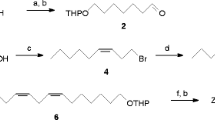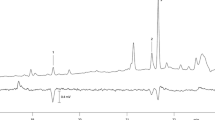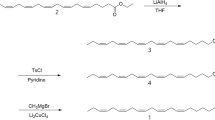Abstract
Two compounds, (E)-11-tetradecen-1-yl acetate and (E,E)-9,11-tetradecadien-1-yl acetate, have been identified in extracts of females of the lightbrown apple moth,Epiphyas postvittana (Walker). The two compounds are active as a coalitive pair and are present in extracts of females in a ratio of about 20∶1.
Similar content being viewed by others
References
Baker, C.R.B. 1968. Notes onEpiphyas (= Austrotortrix) postvittana (Walker), (Lep. Tortricidae).Entomol. Gaz. 19:167–172.
Bartell, R.J., andLawrence, L.A. 1973. Reduction in responsiveness of males ofEpiphyas postvittana (Lepidoptera) to sex pheromone following previous brief pheromonal exposure.J. Insect. Physiol. 19:845–855.
Bartell, R.J., andLawrence, L.A. 1977. Reduction in responsiveness of male lightbrown apple moths,Epiphyas postvittana, to sex pheromone following pulsed pre-exposure to pheromone components.Physiol. Entomol. 2:89–95.
Bartell, R.J., andShorey, H.H. 1969. A quantitative bioassay for the sex pheromone ofEpiphyas postvittana (Lepidoptera) and factors limiting male responsiveness.J. Insect Physiol. 15:33–40.
Bellas, T.E. 1975. A computer program for calculating linear and logarithmic retention indices in gas chromatography,Chromatographia 8:38–40.
Bellas, T.E., andBartell, R. J. 1983. The dose-response relationship for two components of the sex pheromone of the lightbrown apple moth,Epiphyas postvittana (Lepidoptera: Tortricidae),J. Chem. Ecol. In press.
Bennett, C.A., andFranklin, N.L. 1954. Statistical Analysis in Chemistry and the Chemical Industry. Wiley, London, pp. 51–54.
Beroza, M., andBierl, B.A. 1967. Rapid determination of olefin position in organic compounds in microgram range by ozonolysis and gas chromatography.Anal. Chem. 39:1131–1135.
Bjostad, L.B., Taschenberg, E.F., andRoelofs, W.L. 1980. Sex pheromone of the chokecherry leafroller moth,Sparganothis directana.J. Chem. Ecol. 6:487–498.
Brownlee, R.G., andSilverstein, R.M. 1968. A micro-preparative gas Chromatograph and a modified carbon skeleton determinator.Anal. Chem. 40:2077–2079.
Buser, H.-R., Rauscher, S., andArn, H. 1974. Sex pheromone ofLobesia botrana: (E,Z)-7,9-dodecadienyl acetate in the female grave vine moth.Z. Naturforsch. 29c:781–783.
Danthanarayana, W. 1975. The bionomics, distribution and host range of the light brown apple moth,Epiphyas postvittana (Walk.)(Tortricidae).Aust. J. Zool. 23:419–437.
Descoins, C., andFrerot, B. 1979. Sex pheromone specificity in the Tortricid fauna of apple-orchards, pp. 181–185,in F.J. Ritter (ed.). Chemical Ecology: Odour Communication in Animals. Elsevier, Amsterdam.
Geier, P.W., andSpringett, B.P. 1976. Population characteristics of Australian leafrollers (Epiphyas spp., Lepidoptera) infesting orchards.Aust. J. Ecol. 1:129–144.
Hewlett, P.S. 1969. Measurement of the potencies of drug mixtures.Biometrics 25:477–487.
Hill, A., Cardé, R., Comeau, A., Bode, W., andRoelofs, W. 1974. Sex pheromones of the tufted apple bud moth (Platynota idaeusalis).Environ. Entomol. 3:249–252.
McDonough, L.M., Huffman, M.P., Bierl-Leonhardt, B.A., Smithhisler, C.L., Bailey, J.B., andDavis, H.G. 1982. Sex pheromone of the avocado pestAmorbia cuneana (Walsingham) (Lepidoptera: Tortricidae): Structure and synthesis.J. Chem. Ecol. 8:255–265.
Roelofs, W.L., andComeau, A. 1971. Sex pheromone perception: Electroantennogram responses of the red-banded leaf roller moth.J. Insect Physiol. 17:1969–1982.
Roelofs, W., Comeau, A., Hill, A., andMilicevic, G. 1971. Sex attractant of the codling moth: Characterization with electroantennogram technique.Science 174:297–299.
Tamaki, Y. 1977. Complexity, diversity, and specificity of behavior-modifying chemicals in Lepidoptera and Diptera, pp. 253–285,in H.H. Shorey and J.J. McElvey, Jr. (eds). Chemical Control of Insect Behavior. Wiley, New York.
Tamaki, Y., Noguchi, H., andYushima, T. 1973. Sex pheromone ofSpodoptera litura (F.) (Lepidoptera: Noctuidae): Isolation, identification, and synthesis.Appl. Entomol. Zool. 8:200–203.
Zimmerman, E.C. 1978. Insects of Hawaii, Vol. 9. University of Hawaii, Honolulu, pp. 460–462.
Author information
Authors and Affiliations
Additional information
Visiting scientist from New York State Agricultural Experiment Station Geneva, New York 14456 (deceased)
Rights and permissions
About this article
Cite this article
Bellas, T.E., Bartell, R.J. & Hill, A. Identification of two components of the sex pheromone of the moth,Epiphyas postvittana (Lepidoptera, Tortricidae). J Chem Ecol 9, 503–512 (1983). https://doi.org/10.1007/BF00990222
Received:
Revised:
Issue Date:
DOI: https://doi.org/10.1007/BF00990222




